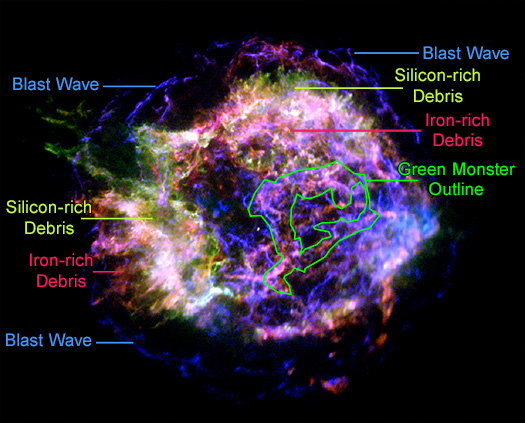Captured in JWST images, a bizarre feature of the supernova remnant Cassiopeia A that was named the “Green Monster” has been revealed to be made of material that existed before the explosion. A team of astronomers has found it is composed of concentrated filaments of gas within broader sheets that differ from the rest of the remnant by lacking tell-tale elements produced in the deaths of big stars.
Almost 12,000 years ago, a star exploded in the Perseus Arm of the Milky Way, the next arm out from our own. Because the star was 11,000 light years away, the light did not reach us until the 1690s. There’s some puzzlement as to why astronomers enjoying their newfangled telescope toys didn’t record its light. Nevertheless, since the discovery of radio emissions from the aftermath, plenty of effort has gone into making up for that – even building a telescope purely to study Cassiopeia A for 15 minutes.
Inevitably, the JWST had a look, and found something that had not been seen before. The feature in question is not really green, since the JWST can’t capture wavelengths that short. However, that was the color assigned to the wavelength in which the filaments glow. Once someone thought they saw a resemblance to the left field wall at Fenway Park, the name was locked in.

Cassiopeia A as seen by the Chandra X-ray telescope with wavelengths of X-rays shifted to visible light and labelled by element enrichment
Image Credit: NASA/CXC/SAO
Based on JWST observations alone, astronomers couldn’t work out the Green Monster’s nature. Its location suggested it was ejecta (material thrown off in the explosion), but other aspects suggested it might be composed of material that surrounded the star before it exploded. A revisit by the JWST later in the year turned up new features of Cassiopeia A, but didn’t resolve the initial question.
Now, the Chandra X-ray observatory has come to the JWST’s assistance. “We already suspected the Green Monster was created by a blast wave from the exploded star slamming into material surrounding it,” said Dr Jacco Vink of the University of Amsterdam in a statement. “Chandra helped us clinch the case.”
Seen in X-rays, Cassiopeia A is truly a hot mess composed of a mix of outrushing gas and dust shaped by magnetic field lines and energetic electrons. Tendrils of gas whose locations match those of the Green Monster were identified as being low in iron and silicon compared to the supernova debris. That’s a strong indicator of not being the product of the explosion.
The circumstellar material (CSM) that makes up the Green Monster was probably mostly thrown off the doomed star before it exploded, but some may have been there from the beginning.
Chandra images also reveal the Green Monster’s material is moving towards us at 2,500 kilometers per second (1,553 miles per second), almost 1 percent of the speed of light. Put away any worries about incoming green space monsters, however. Despite having traveled an impressive fraction of a light year, it is safe to say it will run out of energy long before it can consume Earth.
The Green Monster is moving at about half the speed of the blast wave of CSM that surrounds Cassiopea A, which Vink and colleagues attribute to greater density. “We concluded that the Green Monster is also part of the blast wave and is photobombing the central part of Cas A rather than being part of it,” said Professor Ilse De Looze of Ghent University.
Additional detail was added using NASA’s Nuclear Spectroscopic Telescope Array (NuSTAR), which mapped radioactive titanium produced in the explosion.

Space telescope images of Cassiopeia A showing the debris from the explosion including areas rich in Radioactive Titanium and Iron
Image Credit: NASA/CXC/SAO
These three instruments, and the Hubble and Spitzer space telescopes, each see different aspects of the nebula most clearly. The team has brought together data from all five to create what they call the most detailed 3D image of an exploded star. Together, these tell a complex story of the mixing of material from the CSM, the progenitor star’s outer layers, and the products of the explosion itself.
The results have been submitted to the Astrophysical Journal Letters in two papers, preprints here and here, and were presented at the 243rd meeting of the American Astronomical Society.
Source Link: Mystery Of The “Green Monster” Hidden In Supernova Remnant Solved